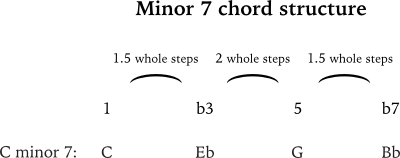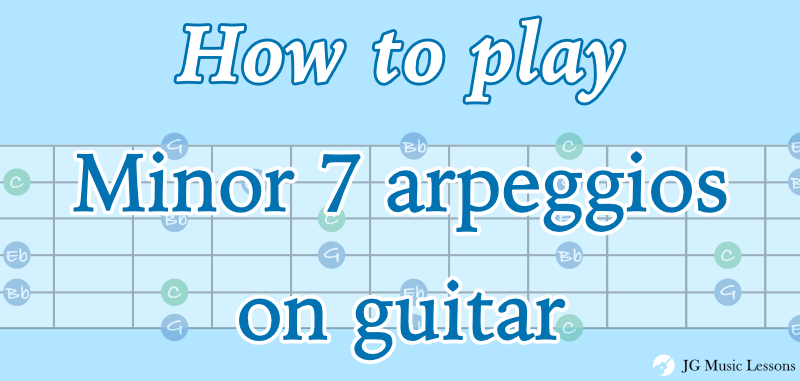If you want to take your improvisation skills to the next level, it’s important to have a solid understanding of minor 7 arpeggios. Arpeggios are so effective because they highlight the important notes of a chord.
If you’re familiar with minor triads, this concept goes one step further to include another note in the chord structure.
In this post, we’ll specifically look at how to play minor 7 arpeggios shapes on guitar and application examples over different chords. Grab your guitar and let’s start learning!
Understanding Minor 7 Arpeggios
Before learning to play arpeggios, it’s important to understand what minor 7 chords are and how they are built. Every minor 7 chord is built upon the following four chord tones: 1, b3, 5, and b7. These chord tones can also be thought of as the scale degrees related to a minor scale.
For example, the C minor 7 chord has the chord tones C, Eb, G, and Bb. This is essentially a C minor chord with an added flat 7th chord tone.
Here is the formula for minor 7 chords below.

Now that you know what notes belong to the minor 7 chord structure, let’s look at how to read the chord charts.
How to read the chord charts
For the chord charts below:
- The top horizontal line of the chord chart represents the high E string and the bottom horizontal line represents the low E string.
- The vertical lines separate each fret.
- The green dots represent the root note.
You can check this link for more on how to read guitar notation symbols.
Minor 7 arpeggio shape 1
Here is the first shape with the root note starting on the 6th string. You can use any root note to play these examples but we will cover application examples later in this post.
For the following charts, the left side shows you the suggested fingering for an arpeggio and the right side shows you what chord tones you are playing.

Minor 7 arpeggio shape 2

Minor 7 arpeggio shape 3
Now, here is the minor 7 arpeggio shape with the root note starting on the 5th string.

Minor 7 arpeggio shape 4
Here is another way you can play the arpeggio with the root note on the 5th string.

Minor 7 arpeggio shape 5

All arpeggio shapes on the fretboard
To help you connect all the shapes we learned, here are all the arpeggio shapes on the fretboard using an A minor 7 chord arpeggio.
A minor 7 arpeggios

E minor 7 arpeggios
Here are all the arpeggio shapes on the fretboard using an E minor 7 chord arpeggio.

G minor 7 arpeggios
Here are all the arpeggio shapes on the fretboard using a G minor 7 chord arpeggio.

Minor 7 arpeggio application examples
Now, we’ll look at some application examples of using arpeggios over a C minor 7 chord. You can listen to each example below the notation with tabs.
Application example 1
This first example uses an ascending four note pattern using only the C minor 7 chord tones: C, Eb, G, and Bb.

Application example 2
Next, we have a descending arpeggio pattern which skips one note after every chord tone.

Application example 3
Example 3 incorporates the minor 7 arpeggio with other scale and chromatic notes.

Application example 4
Example 4 includes arpeggio note skipping, scale notes and a hint of the minor pentatonic scale in measure 2.

Application example 5
Lastly, example 5 incorporates the minor 7 arpeggio with the blues scale and some chromatic notes.

Wrapping up
Arpeggios are a foundational part of improvisation because they highlight the important notes of a chord. If you practice this concept, you’ll find that your solos have much more clarity over the chords you’re playing over.
As you become more comfortable playing arpeggios over a specific chord, also try incorporating other scale notes or try different rhythmic ideas to make your ideas sound more musical. You can also challenge yourself to play arpeggios examples or ideas over different chords.
Check out these other posts to learn how to play Major 7 arpeggios, Dominant 7 arpeggios, or half diminished arpeggios on guitar.
I hope this helps you to create more interesting ideas when improvising. Happy practicing!
📘 Get the free guitar practice guide here!
Best,
JG Music Lessons
Start Playing Better, Faster
with Pro Membership! ✨
Get the guidance, tools, and support that keep your progress on track:
🏁 Always know what to practice next. Access the full Guitar Learning Roadmap with lessons in sequence.
🎼 Play songs with confidence. Step-by-step lessons of popular, classical pieces and other styles.
📙 Save time and frustration. Clear PDFs and ebooks that save time so you can focus on playing.
🎟️ Get rewarded for consistency. 2 free downloads every month (a $240+ yearly value).
🎁 Keep costs low while you grow. 50% off all charts, tracks, and posters — up to 75% off bundles.
🚫 Stay focused. Ad-free environment keeps you in the zone.
💬 Get help when you need it. Direct member support to keep you on track.

